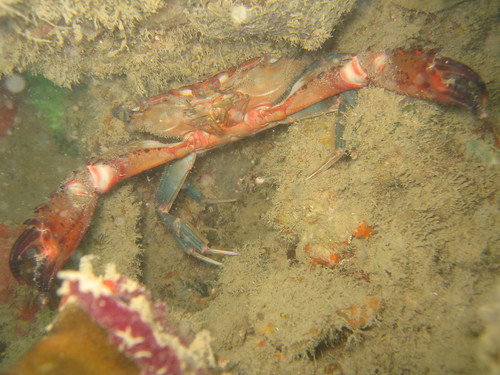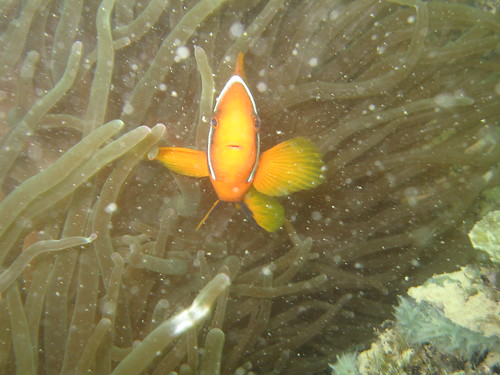Blog Log! November 18!
 December 20, 2007
December 20, 2007
Sorry this post has taken awhile, but here it is! Alas! Apologies to those who have been checking in frequently for updates! I’ve got some videos from the November dive to post as well and will work on that once this gets out. For the holiday season, the Hantu Blog closed it’s monthly dives and will resume the Blog dives in the New Year. We are now reaching the end of the 3rd year of the Hantu Blog and are looking forward to commemorating our 4th year of awareness building come March 2009! We hope you’ll join us for our annual Anniversary dives that are only the most exciting dive trips you can have at Hantu Island. Our experienced dive guides are possibly some of the best Hantu divers to experience local waters with!
Swimmer crabs are one of the most difficult creatures to photograph on our reefs because they are extremely skittish, shooting off into crevices on the reef almost as soon as they are spotted. Once they are cornered though (such as the one above!) they put up a mean defense and will readily nip whatever is threatening them. This is their defensive pose. It may be a small creature and not seem formidable, but those pincers are deceptively sharp and very effective!
Some colonies of coral were found covered with a kind of tiny flatworm (above left on porites, and centre on fungia). The worms don’t cause the coral to bleach per se, but because they block out the light, the zoxenthelle eventually leaves the coral and causes it to bleach.
Other cool creaturs we saw included a small school of razorfish (left) which swim upside down, mimicking the movement of drifting blades of seagrass. They can be quite a challenge to photograph too because they are so razor thin (hence the name!). Once they turn away from you they practically disappear from view! Apart from the commonly spotted phyllidia sea slugs (2nd from left and center) and flatworms (right), dive guide and Reef Friends volunteer Jimmy Goh also photographed a tiny flathead (2nd from right) seeking shelter under the shell of a spent cowrie.
Another thing that Jimmy spotted was the Rubble pipefish above. These fish are occasionally encountered on our reefs and are one of the more common species of pipefish at Hantu. They may be abundant in certain areas of the Indonesian island, with as many as 10 found on a single coral colony! They are so-called because they are usually found on patches of coral.
Other invertebrates encountered included crinoids or feather stars (left), icon seastars (2nd from left) and tube worms or feather duster worms (4th and 5th picture).
Nudibranches are one of the favourite creatures to discover in Hantu’s reefs as there are several species. Some of them can be very tiny, only about the size of a pinhead, but we’ve also come across some nudibranches as large as a clenched fist! One of my personal favourites on the reef are the Trapezia crabs. They are usually found hiding deep within a colony of acopora coral and can be very very trying to photograph because they are quick to hide and there are endless creases in the coral in which they can squeeze their little bodies into. Also in same coral, I found 2 acopora gobies. Photographing them is even more of a challenge! They are super fast and dash away form any threat in less than a blink of an eye. My patience eventually wore out after hovering above the coral trying to get their picture for close to 10 mins! Trapezia crabs are known to be able to defend a coral colony from the coral-eating Crown of Thorns seastar, which does not occur in significant numbers on Hantu’s reef.
This Tomato clown anemonefish may seem cute and adorable, but it is anything but! Lunging itself toward my camera, it attempts to get me out of a threatening distance. When in need of protection, it can dive into the somewhat safe tentacles of its home anemone or even under it. Such behaviour makes is easy target for marine fish poachers. If you keep a marine aquarium at home, please ensure that the shops you purchase your fish and coral from come from a sustainable source. This can often be determined by the pricing of the fish, though it is not necessarily a reliable judge. Best you do as much research as you can!
That’s it for now! swing by soon for videos from the November dive and see you again in January! Happy Holidays!























 Posted in
Posted in 



 content rss
content rss
COMMENTS